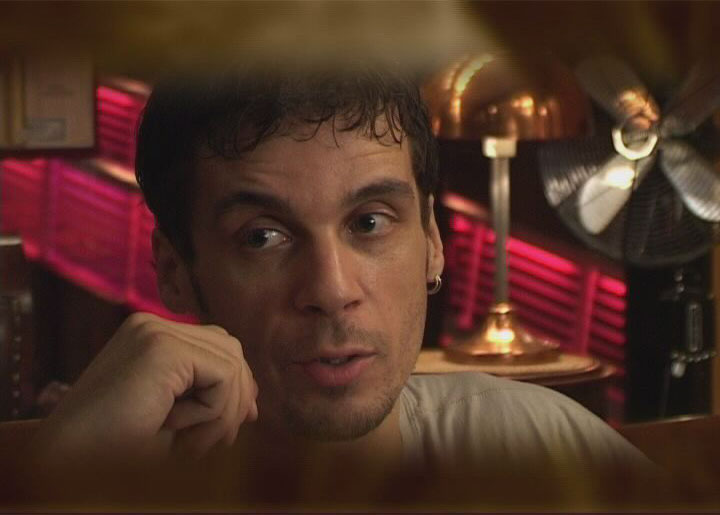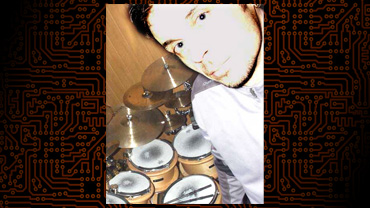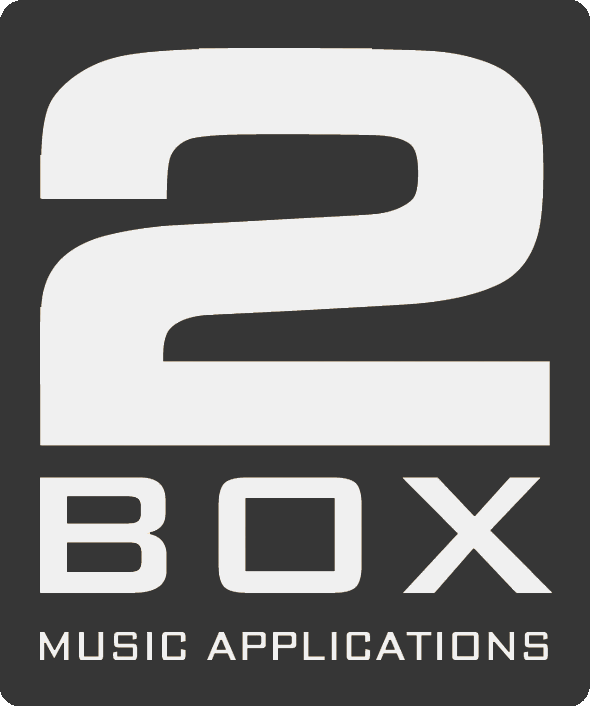 |
Interviews"For me, it has always been a critical issue how authentically and closely the disclosing reporter, photographer, cameraman or even sound engineer could convey the musical and other thoughts and ideas I addressed at the world. There are few things that bring me down more than sitting in for an interview and then, when it is published or broadcast – being confronted with the fact that my discussion partner had not glimpsed the faintest idea of what I meant. Unfortunately, this happens more and more often." |
 |
Endre HuszárDobos (Drummer) magazine, 2007 Over the last twenty years the Hungarian public has seen many faces of Endre Huszár; he has been active as a drummer, composer, journalist, and radio broadcaster. A few years ago he appeared in 9:30 Collective, a very special group of excellent musicians, which in spite of the positive reception only rarely performs, and then withdraws from the public eye. My first question was about the reasons for this "hermit-like" way of life. |
|
-There's nothing conscious in it. It's simply that we're dealing with an international production, difficult to organize and technically complex, that requires the coordination of the work of at least 15 people. Unfortunately circumstances today are not at all suitable to be able to do this regularly. Especially not if I have to manage it, because I'm completely incompetent at that. Sometimes I pull myself together, and we do a few concerts at big festivals, then a long while has to pass before I throw myself into it again. A couple of months ago I thought how funny it is that the film of the 9:30 Collective concert in the Új Színház (New Theatre, Budapest) was shown on Duna TV and on m1 (television) more often this year than we gave concerts over the last two years. -Who is in the band now? -The last disc has a line-up of fifteen. The American Desney Bailey, Orsi Kozma, Bea Tisza, and Gábor Winand sang, on bass were the Polish Krzysztof Scieranski, Marius Norbert from New York, Viktor Hárs and György Szappanos, our guitarist Tamás Mohai, János Nagy on keyboards, Sándor Zsemlye on saxophone, Látó Frankie on violin, and Sándor Födo and Tamás Kovács on percussion. There were eleven of us at the first few concerts, then later as a result of my austerity measures we managed to downsize to seven, but there are still plenty of us, from three different countries too, so even now organizing things is not simple. -How did you get into drums? -I started learning piano when I was six. I was thirteen when my teacher retired, and then I did too. Nearly a year went by before I realized that this was no good, and then I started going to drum lessons. Unfortunately I didn't start at the right place, so my first year can be considered wasted. But then came Iván Nesztor, who gave me lessons I still benefit from, not just in drumming, but in musicality generally. Since then I've seen masses of educational material and videos, so now I know for sure that what Iván did from the end of the 70s was in many respects world class. Then there would have been the entrance exams for the jazz department, which I missed because of tendonitis, so I applied for maths and physics, and I got in. A year later I started drumming once more, but I didn't apply to the jazz department again. Instead I finished my degree and played in all sorts of bands. One was a funny bunch called the "Pink Bombers", which was interesting partly because an 11-piece band could be fairly successful in the playback epidemic, which was just starting then. The line-up wasn't bad, and many of them are active today: Gyuri Demeter and Ildikó Keresztes sang, Laci Kicska (Edda) was on bass guitar, Guszty Perger on drums, and Kornél Fekete-Kovács was amongst the winds. If I heard the disc today I'd be sure to find it strange, but at the time we loved it. Then in 1989 came Ádám Török and the Mini (the band), where I spent a very useful year. We did lots of concerts in Hungary and played the bands first tour in Switzerland. Unfortunately it was just then that the previous structures for live music collapsed in Hungary, so with no normal clubs it was difficult for bands to operate. Maybe that was why Ádám, I believe, is unwilling to think back to this time, though musically what we were doing was interesting. We recorded a disc that wasn't released and we had a live TV broadcast, which disappeared without trace into Hungarian Televisions wonderfully organized archive. I'd like to say: if anyone's got it, I'm interested. -When did you start writing music? -Even as a child I was doing dreadful experiments, such as fitting metal covers onto the hammers of the piano at home, that kind of thing. Things really started in 1990 in London, where I lived for two years. I had no chance to practise there, but I missed music, so I started recording all sorts of sketches on a friend's synthesiser. Some of these were useable. Abroad I met a saxophonist-singer called Sandra Grant, who was in several bands known at the time, such as Soul II Soul, or later Tori Amos. Together we formed the short-lived band Brainwash, which released a CD in Hungary in 1994. Wrong time, wrong place, but I'm not complaining, because the disc wasn't that good either. But re-orchestrating two numbers from the CD, in 1996 I entered a competition organized by one of the most influential organs in the music industry, Billboard magazine, and one of them managed to make it to the finals of the pop category from several thousand other songs, which really surprised me, because the piece wasn't a particularly popular genre and what's more as far as I know a Hungarian band had never managed that. -How did 9:30 Collective get started? -In 1995 there was a trendy club, the Biliárd 1/2 10. They came up with the idea that György Szappanos should do a solo disc. I was originally involved in two or three numbers, but as time went on I noticed that no progress was being made, except for what I was doing myself. So I found myself being the producer of the disc, and the composer of most of the tracks, but at the time there was no band. This idea came from my musician friends who were involved, and most of whom really liked the material. They started to suggest it would be good to do it live. I wasn't that keen on being a patrol leader again in an utterly anti-music, anti-musician milieu, but that's what happened. At any rate I knew who to choose from for the live line-up: on the disc Sandra Grant layed saxophone and sang, Miki Birta, Janó Kormos and Tibor Tátrai played guitar, Sándor Zsemlye was on saxophone, Kornél Fekete-Kovács on trumpet, János Nagy and Gábor Kovács on keyboards, Gyuri Szappanos on bass guitar, Jamie Winchester did the rap, Gergo Borlai and I played drums. The disc got very good reviews. We gave a couple of concerts, a TV broadcast was made from Petőfi Csarnok, and that was it. It's really not my thing to be pinned down by various idiots in a discussion about why it's good for them to have us play in their venue, especially not for the sum a production like that costs. -More than ten years ago you wrote articles in Zenész Magazin [Musician Magazine] and other print media. How did you get into journalism? -I don't remember exactly. After I came back from England, more or less simultaneously I started to do contract work for Petofi Radio and write for various papers. I mostly did interviews and portraits of musicians, the international stars who visited Hungary. I remember my first interview was on the radio, with Black Sabbath. This was followed by countless others, regardless of genre, from Aerosmith to Zawinul, probably all through the alphabet. I gained much from these conversations, and judging by the feedback, I think that mostly the musicians liked speaking to me too. I suppose they were grateful not to be asked questions about their favourite food and latest break-up by a reporter who'd studied the gossip columns. I liked writing very much, but sometimes I had to take a break, being short of time. The first time was in 1996, for five years, when I was a director of a commercial radio station, and most recently two years ago. -Some people may still remember that at the end of the '80s you used all sorts of electronic stuff in Mini. -Right from the start I was always interested in new technologies, and ways the sound of the drum could be extended, so starting from analogue drum machines right up to the newest things, such as the Synesthesia Mandala, I know them all and unfortunately many of them I also buy. It seems I'll never be able to drop the habit. In my view, very few people use these tools in a truly interesting, creative manner. The same thing is true if you sit a pianist in front of a synthesiser. If he tries to play the piano on it, it'll be awful, but if he knows it's another instrument that has to be played differently, then it'll be all right. In the case of drummers it's worse, in that far fewer of them understand what these things are for. Most drummers aren't even interested, although in this era of bedroom computer warriors, the drum is the first instrument to be cut from the recordings to be replaced by a ready-made drum loop. That's exactly why drummers should feel at home in this field, because then perhaps they'd feel less vulnerable and lost when they hear someone say "the sampling CD will be fine for this, you don't need to come into the studio". And I think the same is just as true for studio technology. There is no time to discuss here why in Hungary in 2007 only in the rarest of cases do they manage to record and mix an acoustic drum properly. It must be our fate as a nation, like being unable to speak languages, or build motorways without scandals. -What instrument do you play? -Twenty-five years ago I bought a Yamaha Recording Custom, then later a Stage Custom. I like both very much, but the year before last I bought something which is perhaps unique. I guess the Peavey Radial Pro 1000 must have been the most unfortunate and most underestimated product in the history of drum-making. It was manufactured only for a few years. The market couldn't accept the strange form, yet it was a result, or concomitant of the design concept of a completely unique instrument. It'd take too long to go into the details of the concept, but the point is that it really works in sound, and to this day I can barely believe what I hear when I sit down behind it. I couldn't fit my ddrum triggers to these drums, and the positive side of that was that I had to find another solution for electronic sounds. That's how I came across the Roland sensors, which don't come into contact with the skins at all. Because the thing is so large that apart from a drum snare pad and a Roland Octapad there's no space in it for other pads, I use the triggers on the toms instead of pads. I use the rubber designed by Roland to mute the rim shot in a new way. The rubber fitted to the metal hoop of the tom enables me to play just the electronic sound, just the acoustic one, or a mix of the two, depending on where I strike it. It's still pretty fresh, and I have to play around with it a lot, but I can already see that this is the most versatile equipment I've worked with. -What are you planning for the near future? -One of the most important jobs is to finish my studio, which will be interesting for me as a drummer, because I don't know many recording rooms in Hungary that aren't over-large and yet still have properly treated acoustics for making good recordings. Aside from this, this year I met a fantastic duo, Alien Chatter, with the American Rodney Lee on keyboards and the Indian-Canadian Satnam Ramgotra on tabla and drums. There are many common threads between their thinking and that of 9:30 Collective. On 10 March we'll be doing a gig in the Palace of Arts, and I've invited them, it'll be very interesting. We'll try to take this joint gig out of Budapest too, which won't be easy because of the technical hurdles, especially for me, because I hate peddling my own goods. G. L. |



